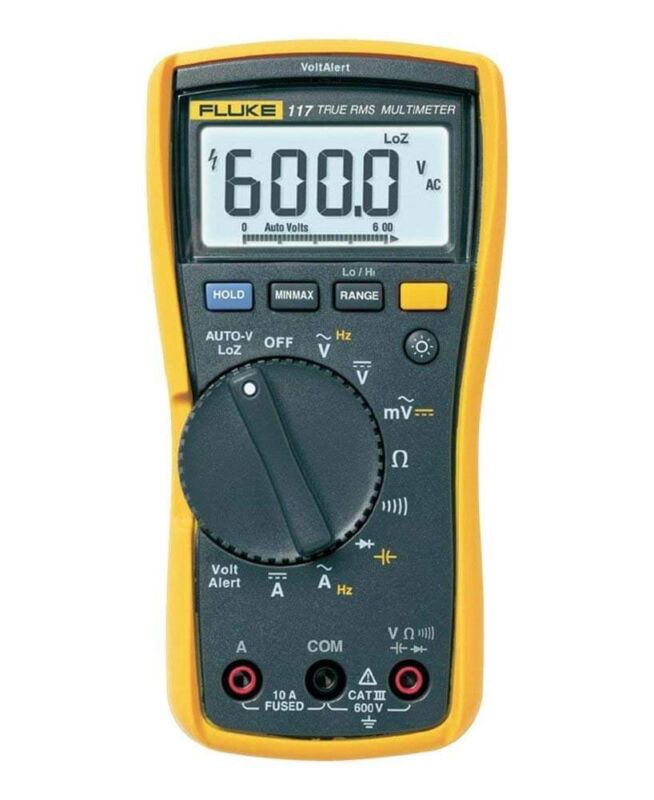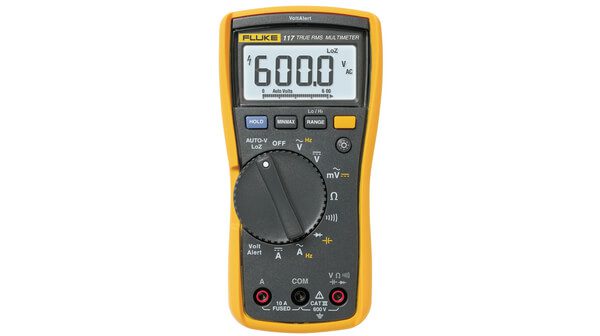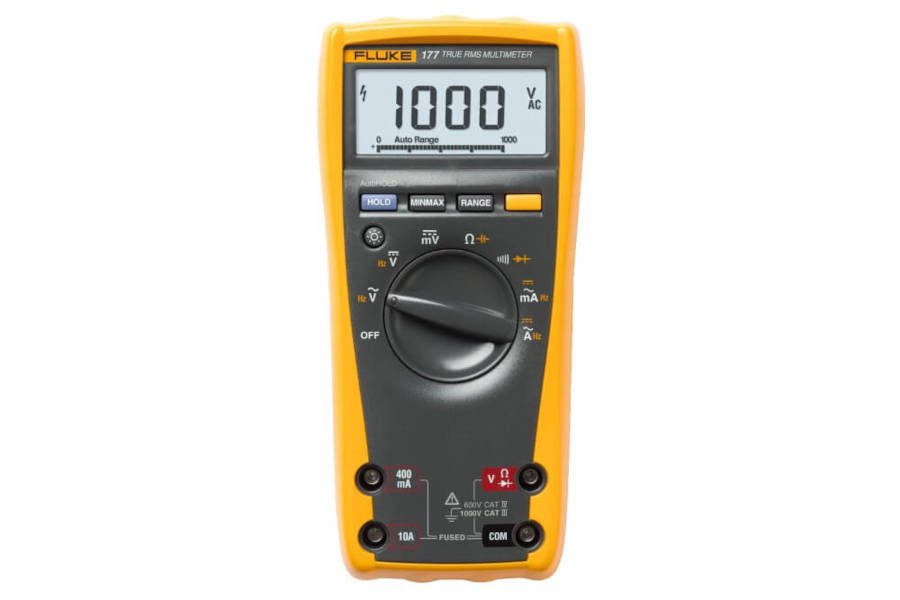
Multimeters can be a technician’s best tool when dealing with projects requiring a variety of diagnosis work. The Fluke 117 and 177 are two of the leading products available in this market. Both devices exhibit excellent quality, with the 177 alternative representing a better choice for those interested in frequent diode testing activities.

Identifying a multimeter suitable for your needs is not always as easy as you might think. There are a number of aspects to consider when choosing the most appropriate option for your needs.
Fluke 117 Multimeter
VS
Fluke 177 Multimeter
If you’re looking for an alternative for various DIY projects around the house, for instance, then acquiring a model with a general range collection is probably all you might need. However, if you’re intent on working in a specific field with particular needs, then additional features and capabilities might come into play.
The Fluke 117 vs. 177 are two leading products in this sector, with both meters offering great value for money with their provisions. The Fluke 177’s range also includes milliamps, a category that is not available with its 117 counterpart.
Differences between Fluke 117 vs. 177 – How do they compare?
| Model | Fluke 117 | Fluke 177 |
| Safety Ratings | CAT III 600V | CAT III 1000V/ CAT IV 600V |
| Low input impedance | Yes | No |
| Diode Testing | No | Yes |
| Weight (g) | 590 | 420 |
| Check price | Check price |
Fluke 117 vs. 177: What is the difference?
Safety Ratings and Warranty
One of the primary factors to consider when examining the quality of a particular choice is the safety ratings and warranty that’s available with different options. Even products from the same manufacturer can feature different provisions in this category, depending on the type of product involved.
As mentioned earlier, the Fluke 117 was designed for general use, and as such it doesn’t exhibit a lot of high-end features with its design. The 177, on the other hand, was developed with the issue of professional performances in mind.
These objectives are reflected in the safety ratings and warranties available which each alternative.
The Fluke 117 boasts CAT III 600V safety ratings, as well as a three-year warranty with the device. The 177 takes this a step further through the integration of CAT IIII 1000V and CAT IV 600V safety ratings, making it more suitable for a variety of environments.
It also comes with a lifetime warranty, which portrays the confidence the manufacturers have in the quality of this model.
Additional Features
The sort of work intended for the multimeter you purchase will determine the particular features you might need to look out for. Though both the Fluke 117 vs. 177 represent quality options in the market, one alternative might be more suitable than the other when it comes to particular needs.
The 117 comes with a range of general options that allows you to address a number of issues including capacitance, resistance, and voltage measurements to name a few. It also includes a non-contact voltage detection system that enhances the safety of the user when working with potential live wires.
This model also features low input impedance, which is great for the identification of ghost voltages that lead to the development of false positives.
The Fluke 177 represents a more advanced version of its counterpart, with a variety of functions included that are not present with the 117 alternative. One of the main elements that make this line so attractive, for example, is its ability to conduct diode testing operations.
This can be crucial if your work entails a great deal of this activity, and thus can play a significant role in the decision making process.
True RMS Functionality
True RMS is gradually becoming the industry standard in sectors requiring high accuracy readings with their activities. Both the Fluke 117 vs. 177 come equipped with this feature, making them suitable for dealing with issues such as HVAC repair and other electrical-based operations.
These precise AC readings are provided with variable drives enhancing the flexibility enjoyed with the devices. The main aim behind the inclusion of this technology is the provision of highly accurate data regarding an inverter’s output, even when dealing with distorted waves.
The need for this feature was identified after it was established that normal RMS readers didn’t really excel in this capacity.
Management Assistance
One of the primary advantages of using a digital multimeter is the various automated assistance programs that come with the interface. These are features that are designed to make it easier for the user to accomplish their objectives without having to strain their manual capabilities.
Both the Fluke 117 and 177, for example, come with automatic and manual ranging options – meaning you can have the device select the appropriate range during measurement on your behalf.
The Fluke 177 also comes with an Auto hold feature that enables hands-free screen locking capabilities when reading the data provided. The Min/Max average function is designed to select the highest and lowest readings when working with high fluctuations, providing an average of these values for precise data collection.
Build and Quality
The physical features of the device can be just as important as its technical functions, especially when intended for regular use. Both the Fluke 117 vs. 177 come with great quality builds that ensure they will not breakdown after a few months of work.
The ergonomic design of the multimeter makes it comfortable to hold with one hand, and enhances the grip enjoyed by the user. They also come with holsters that enhance the protection offered in cases of mild impacts as a result of mistakenly dropping the item.
Both feature a lightweight factor, with the 117 model weighing in at 590g, and its alternative coming in a bit lighter at 420g. The 177’s dimensions are listed as 7.3 x 3.5 x 1.7, while the 117 alternative comes in at 6.6 x 3.3 x 1.8 (inches). These measurements make both devices easy to store in constricted spaces.
Temperature Measurements
One of the significant ranges related to multimeter work includes temperature. Just like categories such as capacitance and resistance, this element is not always used for a large majority of general purposes, but can be an essential requirement when dealing with particular problems.
Unfortunately, both models don’t offer this element as an inbuilt system. Luckily, you can still measure temperatures, but you will need the inclusion of an external accessory to achieve this function.
This can greatly slowdown your pace in the process, if you have to stop to make a new connection whenever you want to test the temperature of a particular element. With this in mind, it would be easier to just buy a separate tool for your temperature enquiries to work alongside your multimeter.
Either way, the measurement of temperatures with the Fluke 117 or 117 will require additional investment.
Performance and Reliability
The final aspect that should be taken into consideration when choosing a viable option is the level of reliability portrayed by the product. Fluke has dedicated itself to the provision of high quality tools and instruments, and their multimeter collection is no different.
Whether you’re working with the 117 or 177, the performance on offer is good enough to rival any other competitor in the industry. Their digital displays come with a backlight that enhances vision capabilities when working in dimly lit environments.
The results are produced almost instantaneously, ensuring no time is wasted when addressing a problem. With a battery life of about 200 hours, you can comfortably work with the multimeter by your side for extended periods without worrying about it running out of juice midway through the project.
Fluke 117 vs. 177 Review
Fluke 117

The Fluke 117 is a great option for individuals with multipurpose requirements. If you’re a general electrician or are looking for a multimeter to complete a variety of DIY tasks around the house, then this might just be the answer to your needs.
Its compact design makes it easy to work with in constricted spaces, while the sturdiness of the casing ensures it suffers minimal damage when subjected to sudden impact. It also boasts an attractive cost, meaning you won’t have to part with an arm and a leg to get this reliable alternative.
The device is capable of measuring a variety of ranges, including current, voltage, capacitance and resistance. It has drawn rave reviews for the accuracy of the data produced, and the efficient manner in which the said data is provided.
One of the major features of this model is its non-contact voltage detection system, which allows the user to identify a current without having to make direct contact with the surface involved.
This greatly enhances the safety levels enjoyed by the owner during use. It also comes with low input impedance, which enhances the accuracy that can be enjoyed during measurements. This feature distinguishes ghost voltages from actual currents, helping to negate false positives in the process.
It comes with a 9V battery that offers approximately 200 hours of working time before having to recharge the device. Its CAT III 600V safety ratings are supported by a three-year warranty, portraying the overall quality of the device.
Pros
- Non-contact voltage detection
- Compact design
- Affordable pricing
- Reliable battery life
Cons
- Doesn’t function at optimal status when dealing with measurements over 50 kHz
- Doesn’t have an inbuilt thermometer
- Lack of a reliable diode testing system
View price on Amazon
The Fluke 177 Multimeter

The Fluke 177 is an excellent alternative for individuals looking for a little more from their device. This model features all the basic measurements of a regular multimeter, as well as some additional features that make it adaptable to a variety of specialized tasks.
It also offers reliable diode measurements, an aspect that is not available with some alternatives. The device comes in a variety of ranges, including AC/DC milliamps and DC millivolts, expanding the scope of measurements available.
The multimeter features a sturdy and reliable build like its other counterparts in the Fluke line, with the display offering an analogue bar graph to support the data provided.
It has been hailed for its quick responses, which can be a crucial element when dealing with time-sensitive matters, such as a broken machine that is part of an essential production line.
Its True RMS capabilities ensure that you can enjoy the highest accuracy levels when dealing with specific measurements, and allows the device to distinguish ghost voltages. This last factor aids in the negation of false positives when accruing data.
Pros
- Diode measuring capabilities
- Lifetime warranty
- CAT III 1000V/ CAT IV 600V safety ratings
Cons
- It’s costlier than most other alternatives in the market
- The holster fuses with the main casing
- Doesn’t feature micro-amp measurements
View price on Amazon
The Final Verdict
A straightforward comparison between the Fluke 117 vs. 177 reveals that the latter represents the best option in terms of quality and functionality. If you’re looking for a multimeter to conduct some light industrial work, then choosing the Fluke 177 will ensure that you have all the elements you need when working with different equipment.
This option also comes with a lifetime warranty, as compared to the three years on offer with the alternative. The Fluke 117 still represents a good option for those looking for a more general tool at an affordable price.
FAQs
What Is the Main Difference Between the Fluke 117 and 177?
The main difference between these two models can be said to be in the number of features available with both products. The Fluke 177 offers a greater range of options in this category.
Can I Still Test a Live Wire without The Non-Contact Voltage Detection System?
Yes. The AlertVolt technology implemented with this capability is designed to simply make it easier for the user to determine the presence of a live current. You will need to use test leads, however, if your multimeter lacks this feature.
Do All the Fluke Multimeters Come with A Warranty?
Yes. The length and format of the warranty is what varies between different products.
Can I Upgrade My Fluke 117 to Match the Features of Another Model Using External Enhancements?
Unfortunately, this ability is very limited. You can measure temperatures with the addition of a thermo-coupling device, but there are a number of features which cannot be included via external means.


